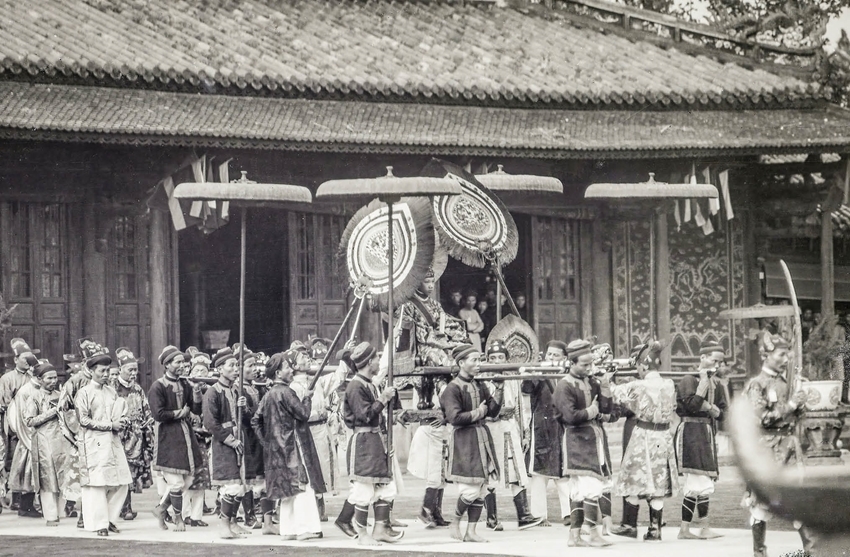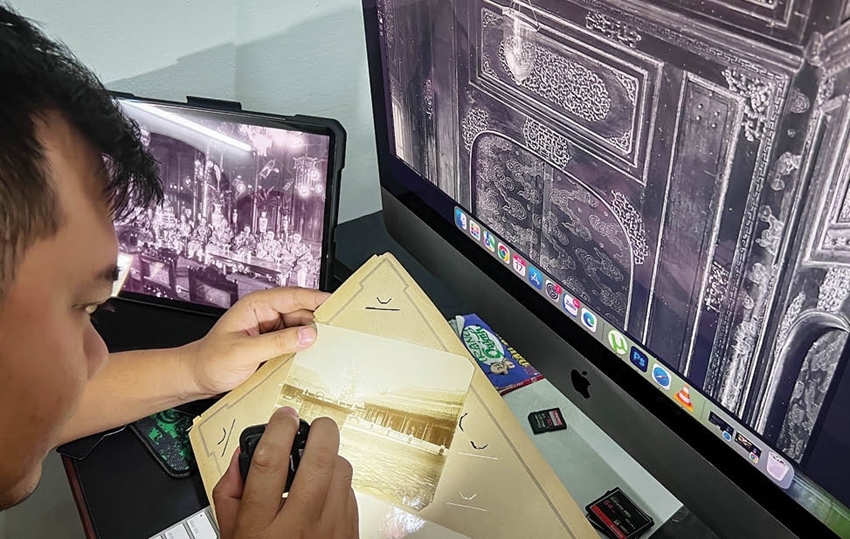 |
| The historical image of emperor Bao Dai is carried out from Can Chanh palace. Photo: Provided by the character |
Adjusting drawings of the “national key project”
Phong reminds of Can Chanh in the peaceful, melodious space of warm tea and lyrical music. This is the palace with the largest and most beautiful wooden structure in the Forbidden City. The palace was built in the 3rd year of Gia Long’s reign (1804) and was repaired many times before completely burnt down in 1947. Currently, the plan to restore Can Chanh Palace is being implemented. This is one of the national key projects on cultural heritage preservation.
It is worth mentioning that, from accurate and scientific details, along with a photo archive after its digitization and clarification, Phong and his team discovered in the drawing file of the Can Chanh Palace restoration project, with the research support of the Japanese for 30 years, there are many inaccuracies with historical photo documents. From there, the group highlighted 16 criticism points, from decoration and architecture... to structures that could change the appearance of Can Chanh, and convinced the council to approve the drawing of the Can Chanh Palace renovation and restoration project of Hue Monuments Conservation Center to extend more time for authentication.
Phong sends a happy text message: “The Japanese made a model of Can Chanh Palace, which is currently on display at Duyet Thi Duong with many incorrect points. These serious inaccuracies have led to changes in Can Chanh's architecture compared to the original. I have approached the new drawing. Everything was perfect and completely mastered and drawn by us, the Vietnamese…”
 |
| Phong is analyzing historical photos. Photo: Provided by the character |
Phong analyzed that the emperor sat on a palanquin inside Can Chanh and was carried out along the middle path to enter Thai Hoa from the back palace. That's why the eave columns of Can Chanh Palace are very high. The height of the door is also much higher than that of existing buildings.
Phong and his team calculated and gave that information based on three critical bases: The height of the glass painting - one of only three antiques identified as originating from Can Chanh Palace and currently displayed at Huu Vu, Hue Citadel, the palanquin carrying emperor Khai Dinh out of Can Chanh palace - original artifact still exists, and glass paintings that once used to be decorated in Can Chanh palace (historical photos).
In addition, if we follow Japanese drawings, the shape of the window on the flanks will be bigger and shorter than those in the documents. This situation stems from the eave columns at the front hall that are too low. Meanwhile, documents corroborated that the eave columns at the Can Chanh front palace are much higher. “Particularly for Can Chanh Palace, my team has the complete scientific basis to ensure the provision of accurate details down to every... screw to return the accuracy to this palace. With clarified documents, analysis, and conclusions, we hope to join hands with relevant units to return Can Chanh to its most complete appearance according to its historical original,” emphasizes Phong.
Thank you for “opening your heart”
Phong’s team includes himself and six colleagues in Hue City and Ho Chi Minh City. Everyone has jobs but meets each other through a shared passion - exploiting and analyzing documents and “love historical photos more than gold”. To obtain valuable historical photos, Phong’s team is almost online 24/7 to “attend” auctions. If there is a historical photo related to Hue, the whole group analyzes the rarity of the photo and then registers to buy it. If they couldn’t afford it, they would try to contact the owner to ask for a look. Yet this is extremely difficult.
“Recently, we transferred a historical color photo of Can Chanh Palace, one of the most precious on the planet, and a short film to the monument management unit. The extremely meaningful value of these documents is that they will let posterity know the color of the tiles used to pave the inner palace of Can Chanh, the color of the horizontal lacquered boards, and other details decorated in the inner palace... The wonderful opportunity to access precious photo sources like this makes my group feel like they have been “prioritized by the superiors”. Because of that, someone calls me “ ‘superiors’ man”, slyly said Phong.
Phong then talked about his first chance to become a “man of the superiors” - the way many still “look” at Phong when he shows his unlimited passion for analyzing historical photos and criticizing research arguments that are not yet convincing. One afternoon, Phong stopped by Hue Monuments Conservation Center to donate a large photo of Empress Nam Phuong, digitized from an original photo with only three fingers in size and bought from France. At the Center, Phong was invited by Mr. Hoang Viet Trung - Director of the Center, to attend a meeting to discuss the approval of the ongoing Can Chanh Palace renovation and restoration drawings. As a result, with information from historical photos, Phong criticized many points in the drawing being submitted for discussion, and then the drawing was given more time to... add information.
Not everyone can easily listen to criticism. Yes - briefly replied Phong. Phong repeated his favorite thing: The most important thing is the person responsible for managing the monuments listens. If not, then accept it. If it weren't for the “fate” of that photo-donating afternoon, there would be a very high possibility that the restoration of Can Chanh Palace would be “returned” as a second Thai Hoa Palace after completion. Meanwhile, the two palaces have entirely different functions and architectures.
With his passion for historical photography and mastering technology, Phong feels fortunate that, at this point, the group has historical photos of many lost works, such as Dai Cung Mon, Kham Van Palace, Thuong Thang pavilion, Hai Tinh Nien Phong Cac in the Co Ha area (Inner Citadel), Thoai Thanh mausoleum, Cuu Tu Dai... The team can even be confident that they have enough materials to serve the restoration of most of the work of the Hue Monuments Complex, which is expected to be restored in the next 20-30 years.
“As long as the monument management unit is “open” to allow us to be engaged in, we are ready to interact and share what we have,” said Phong.
Mentioning Phong’s group as “young people who make others feel strange”, Mr. Hoang Viet Trung, Director of Hue Monuments Conservation Center, admired their passion and love for heritage. He said that restoring and preserving Hue's ancient capital urgently needed historical photo sources, especially images taken and kept by the French during the French colonial period. Fortunately, Phong and his team are working very hard to search, connect, and provide valuable information for the Center’s relic restoration activities.